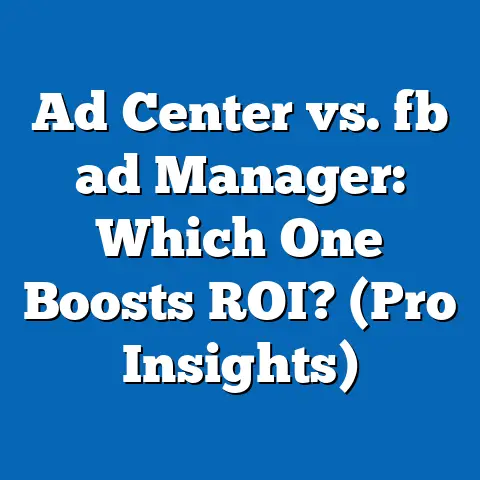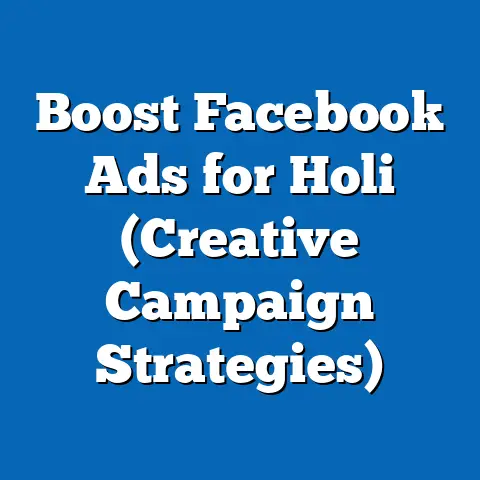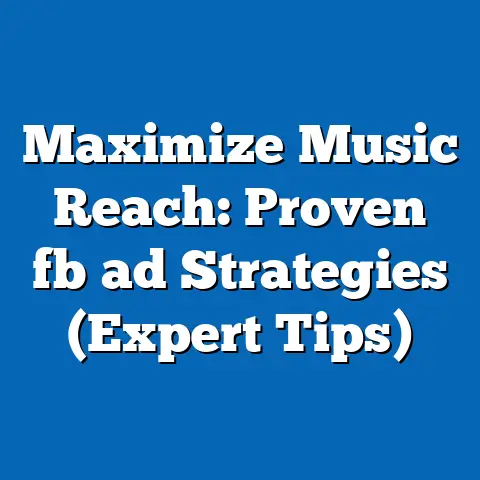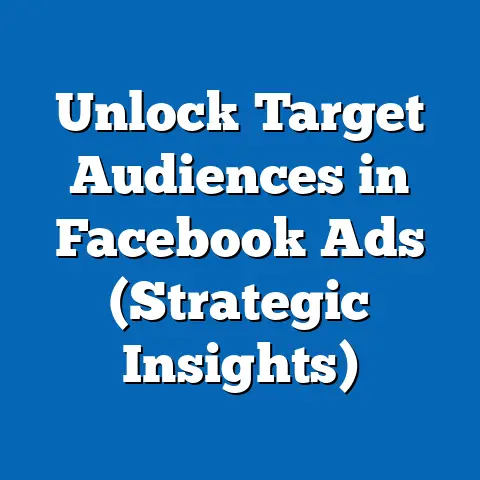Mastering Real-Time Insights (Unlock Powerful fb ad Strategies)
Mastering Real-Time Insights: Unlock Powerful Facebook Ad Strategies
Introduction
As a digital marketer, I’ve learned that success isn’t just about setting up campaigns and hoping for the best. It’s about constant adaptation, understanding the pulse of your audience, and reacting to the ever-changing landscape of consumer behavior. And in today’s world, one of the most significant forces shaping consumer behavior is the climate.
Think about it. A heatwave sends people scrambling for air conditioning and ice cream. A snowstorm keeps everyone indoors, glued to their screens. These aren’t just weather events; they’re triggers that drastically alter what people want, what they need, and what they’re willing to buy.
That’s where real-time insights come in. In the fast-paced world of Facebook advertising, real-time insights are your secret weapon. They’re the key to understanding what’s happening right now and adjusting your campaigns to capitalize on those fleeting moments. They allow you to move beyond broad demographic targeting and tap into the immediate needs and desires of your audience. Ignoring these insights means missing out on opportunities to connect with your audience in a way that resonates deeply and drives results.
In this article, I’ll guide you through the world of real-time insights and show you how to harness their power to create climate-responsive Facebook ad strategies. We’ll explore how climate impacts consumer behavior, how to access and interpret real-time data, and how to use this information to create highly targeted and effective ad campaigns. By the end, you’ll be equipped to transform your Facebook advertising from a static effort into a dynamic, responsive, and incredibly powerful tool.
Section 1: Understanding Real-Time Insights
Defining Real-Time Insights
Real-time insights, in the context of digital marketing and Facebook ads, are the immediate, up-to-the-minute data that reflects the current state of your campaigns and audience behavior. This data isn’t just about what happened yesterday or last week; it’s about what’s happening right now. Think of it as having a live feed into the minds of your potential customers.
Types of Data Available
The beauty of real-time insights lies in their breadth and depth. They encompass a wide range of data points, including:
- Audience Engagement: This includes metrics like likes, shares, comments, and click-through rates (CTR) on your ads. Real-time engagement data can tell you which ads are resonating with your audience and which are falling flat.
- Ad Performance Metrics: Metrics such as cost per click (CPC), cost per acquisition (CPA), and return on ad spend (ROAS) provide a clear picture of your campaign’s efficiency. Monitoring these metrics in real-time allows you to identify and address any performance issues immediately.
- Behavioral Trends: This is where things get really interesting. Real-time insights can reveal emerging trends in your audience’s behavior, such as a sudden surge in interest in a particular product or topic. This information can be invaluable for crafting timely and relevant ad campaigns.
Accessing Real-Time Insights
Facebook provides several tools for accessing real-time insights, with Ads Manager being the primary hub. Within Ads Manager, you can customize your dashboards to display the metrics that matter most to you and track their performance in real-time.
Beyond Ads Manager, third-party analytics tools can provide even deeper insights into your audience’s behavior. These tools often offer advanced features such as sentiment analysis and predictive analytics, allowing you to anticipate future trends and proactively adjust your campaigns.
Real-World Examples
I once worked with a local ice cream shop that used real-time insights to great effect. During a particularly hot summer, they noticed a significant increase in engagement with ads featuring their frozen treats. By increasing their ad spend and targeting users within a specific radius of their shop, they were able to capitalize on the heatwave and drive a surge in sales.
Another example comes from a clothing retailer who used real-time insights to adjust their winter ad campaigns. After a major snowstorm hit their region, they noticed a spike in searches for winter boots and outerwear. They quickly created ads featuring these products and targeted them to users in the affected areas, resulting in a significant increase in online sales.
Takeaway: Real-time insights are the key to understanding the immediate needs and desires of your audience. By monitoring these insights and reacting quickly, you can create highly targeted and effective ad campaigns that drive results.
Section 2: The Impact of Climate on Consumer Behavior
Climate’s Influence on Purchasing Decisions
The climate has a profound influence on consumer behavior and purchasing decisions. This influence extends far beyond the obvious examples, like buying sunscreen in the summer or snow boots in the winter. It affects everything from the types of food people crave to the activities they pursue and the products they need.
Statistical Data and Case Studies
Consider the following examples:
- Seasonality: Studies have shown that consumer spending on clothing and accessories tends to peak during the spring and fall, as people update their wardrobes for the changing seasons.
- Extreme Weather: A study by the National Retail Federation found that extreme weather events can have a significant impact on retail sales, with consumers often delaying purchases or shifting their spending to essential items.
- Climate Change: As climate change continues to impact weather patterns, consumers are becoming more aware of the environmental impact of their purchases. This is leading to a growing demand for sustainable and eco-friendly products.
Segmenting Audiences
Segmenting audiences based on climate-related factors is crucial for effective advertising. This means going beyond basic demographic targeting and considering factors such as:
- Location: Targeting users based on their geographic location allows you to tailor your ads to the specific climate conditions in their area.
- Weather Conditions: Some advertising platforms allow you to target users based on real-time weather conditions, such as temperature, precipitation, and humidity.
- Seasonality: Segmenting audiences based on the time of year allows you to promote seasonal products and services at the most relevant times.
By segmenting your audience based on these factors, you can create highly targeted ad campaigns that resonate with their specific needs and desires.
Takeaway: Climate has a significant impact on consumer behavior and purchasing decisions. By understanding these influences and segmenting your audience accordingly, you can create more targeted and effective ad campaigns.
Section 3: Leveraging Real-Time Insights for Targeted Facebook Ads
Strategies for Targeted Facebook Ads
Now, let’s dive into the practical strategies for using real-time insights to create targeted Facebook ads that speak directly to climate-specific consumer needs.
-
Identify Audience Segments: Start by identifying specific audience segments based on climate-related factors. For example, you might create a segment of users who live in areas prone to heatwaves or a segment of users who are interested in winter sports.
-
Craft Relevant Ad Copy: Use real-time insights to craft ad copy that speaks directly to the needs and desires of your target audience. For example, if you’re targeting users in a heatwave, your ad copy might focus on the benefits of air conditioning or the refreshing qualities of ice cream.
-
Use Compelling Visuals: Choose visuals that are relevant to the climate conditions in your target area. For example, if you’re targeting users during a snowstorm, your ad might feature images of cozy fireplaces or snow-covered landscapes.
-
Implement A/B Testing: A/B testing is crucial for refining your ad copy, visuals, and calls to action. Use real-time insights to track the performance of different ad variations and identify the ones that resonate most with your target audience.
Identify Audience Segments: Start by identifying specific audience segments based on climate-related factors. For example, you might create a segment of users who live in areas prone to heatwaves or a segment of users who are interested in winter sports.
Craft Relevant Ad Copy: Use real-time insights to craft ad copy that speaks directly to the needs and desires of your target audience. For example, if you’re targeting users in a heatwave, your ad copy might focus on the benefits of air conditioning or the refreshing qualities of ice cream.
Use Compelling Visuals: Choose visuals that are relevant to the climate conditions in your target area. For example, if you’re targeting users during a snowstorm, your ad might feature images of cozy fireplaces or snow-covered landscapes.
Implement A/B Testing: A/B testing is crucial for refining your ad copy, visuals, and calls to action. Use real-time insights to track the performance of different ad variations and identify the ones that resonate most with your target audience.
Refining Ad Copy
Let’s say you’re running an ad campaign for a sunscreen brand. Instead of using generic ad copy like “Protect your skin from the sun,” you could use real-time insights to create more targeted messaging. For example, if you know that the UV index is high in a particular area, you could use ad copy like “High UV today! Protect your skin with our SPF 50 sunscreen.”
Visual and CTA Alignment
Visuals play a huge role in ad performance. Don’t underestimate the power of a well-chosen image or video. A/B test different visuals to see what resonates best with your target audience.
Your call to action (CTA) should also align with the climate-specific needs of your audience. For example, if you’re targeting users who are experiencing a heatwave, your CTA might be “Shop now and stay cool!”
Takeaway: By leveraging real-time insights to create targeted Facebook ads, you can connect with your audience in a way that resonates deeply and drives results.
Section 4: Case Studies of Successful Climate-Responsive Facebook Ad Campaigns
Case Study 1: The Coffee Shop
A local coffee shop in Seattle, Washington, leveraged real-time insights to boost sales during the city’s notoriously rainy season. They used Facebook Ads Manager to monitor weather patterns and identify days with heavy rainfall. On those days, they launched targeted ads featuring their hot beverages, such as lattes and cappuccinos, with ad copy like, “Escape the rain with a warm cup of comfort!” and images of steaming mugs. They also offered a small discount to customers who showed the ad on their phones in-store.
Results: The coffee shop saw a 20% increase in sales on rainy days compared to their average daily sales. Their Facebook ads had a CTR of 3.5%, significantly higher than their average CTR of 1.8% on non-rainy days.
Lessons Learned:
- Hyper-Local Targeting: By focusing on a specific geographic area and aligning their ads with the local weather, the coffee shop was able to reach customers who were actively seeking refuge from the rain.
- Timely Promotions: Offering a discount specifically on rainy days created a sense of urgency and incentivized customers to visit the store.
- Relevant Messaging: The ad copy and visuals effectively conveyed the idea of warmth and comfort, which resonated with customers seeking relief from the rain.
Case Study 2: The Clothing Retailer
An online clothing retailer specialized in outdoor apparel used real-time insights to optimize their Facebook ad campaigns during the winter months. They monitored weather forecasts and identified regions that were expecting significant snowfall. In those areas, they launched targeted ads featuring their winter coats, boots, and other cold-weather gear, with ad copy like, “Don’t let the snow stop you! Gear up with our winter essentials.” They also highlighted the features of their products, such as waterproof materials and insulation.
Results: The clothing retailer saw a 30% increase in sales of winter apparel in the targeted regions compared to their sales in non-snowy areas. Their Facebook ads had a conversion rate of 4.2%, higher than their average conversion rate of 2.5% for other product categories.
Lessons Learned:
- Proactive Campaign Planning: By anticipating weather events and planning their ad campaigns in advance, the clothing retailer was able to capitalize on the increased demand for winter apparel.
- Product-Focused Messaging: Highlighting the specific features of their products that were relevant to the weather conditions helped to convince customers that their apparel was worth the investment.
- Visual Storytelling: Using images of people enjoying outdoor activities in snowy conditions helped to create a sense of adventure and excitement, which resonated with customers who were eager to embrace the winter season.
Takeaway: These case studies demonstrate the power of climate-responsive Facebook ad campaigns. By leveraging real-time insights, businesses can create targeted ads that resonate with their audience and drive results.
Section 5: Future Trends in Real-Time Insights and Facebook Advertising
AI and Machine Learning
Artificial intelligence (AI) and machine learning (ML) are poised to revolutionize the way we use real-time insights for Facebook advertising. AI-powered tools can analyze vast amounts of data in real-time and identify patterns and trends that would be impossible for humans to detect. This can help marketers to:
- Predict Future Trends: AI can analyze historical data and predict future trends in consumer behavior, allowing marketers to proactively adjust their campaigns.
- Optimize Ad Spend: AI can automatically optimize ad spend by identifying the most effective ad variations and targeting strategies.
- Personalize Ad Experiences: AI can personalize ad experiences for individual users based on their past behavior and preferences.
Augmented Reality (AR)
Augmented reality (AR) is another emerging technology that has the potential to transform Facebook advertising. AR allows marketers to create interactive ad experiences that overlay digital content onto the real world. This can be used to:
- Showcase Products in Real-Time: AR can allow users to virtually try on clothing, see how furniture would look in their homes, or test out other products in real-time.
- Create Immersive Brand Experiences: AR can be used to create immersive brand experiences that engage users and leave a lasting impression.
- Drive Sales: AR can make it easier for users to make purchases by allowing them to see how products would look and function in their own lives.
Privacy-Focused Advertising
As consumers become more concerned about their privacy, there is a growing demand for privacy-focused advertising solutions. This means that marketers need to find ways to target ads without collecting or sharing personal data. Some potential solutions include:
- Contextual Advertising: Targeting ads based on the content of the page or app that the user is viewing.
- Aggregated Data: Using aggregated data to target ads without identifying individual users.
- Privacy-Enhancing Technologies: Using technologies that protect user privacy while still allowing for effective ad targeting.
Preparing for the Future
To prepare for these future trends, brands need to:
- Invest in AI and ML Tools: Invest in AI-powered tools that can analyze real-time data and optimize ad campaigns.
- Experiment with AR Advertising: Explore the potential of AR advertising to create engaging and immersive brand experiences.
- Embrace Privacy-Focused Advertising: Adopt privacy-focused advertising solutions that respect user privacy while still allowing for effective ad targeting.
Takeaway: The future of real-time insights and Facebook advertising is bright, with emerging technologies like AI, AR, and privacy-focused solutions poised to transform the way we connect with consumers.
Conclusion
Mastering real-time insights is no longer a luxury; it’s a necessity for success in the ever-evolving world of Facebook advertising. By understanding how climate impacts consumer behavior, accessing and interpreting real-time data, and using this information to create highly targeted ad campaigns, you can transform your advertising efforts from static to dynamic and ultimately drive better results.
I’ve seen firsthand how powerful these strategies can be. From the local ice cream shop capitalizing on a heatwave to the clothing retailer clearing out winter gear after a blizzard, the possibilities are endless. The key is to stay agile, stay informed, and always be ready to adapt to the changing needs of your audience.
So, take the first step today. Start exploring Facebook Ads Manager, experiment with different targeting options, and analyze your real-time data. The more you understand your audience, the better equipped you’ll be to create ad campaigns that resonate with them on a deeper level. And as you continue to refine your skills, you’ll be well on your way to mastering real-time insights and unlocking the full potential of Facebook advertising.






